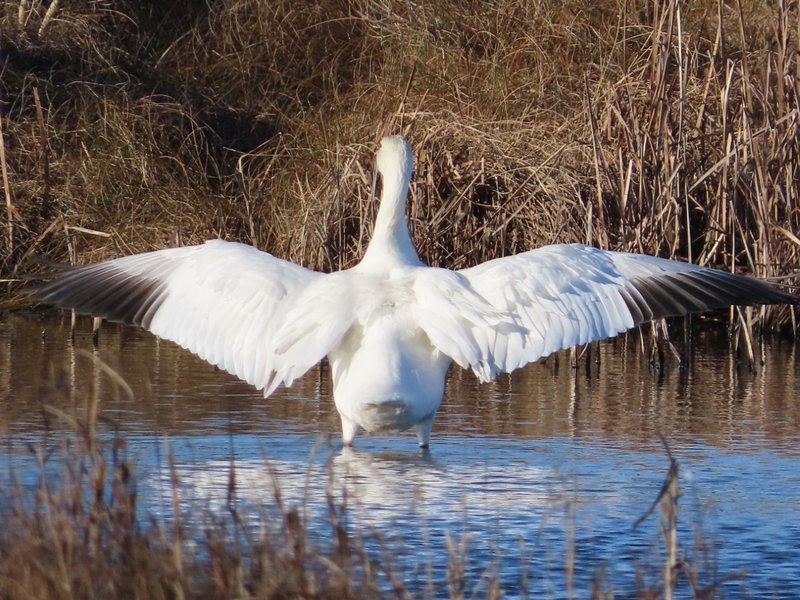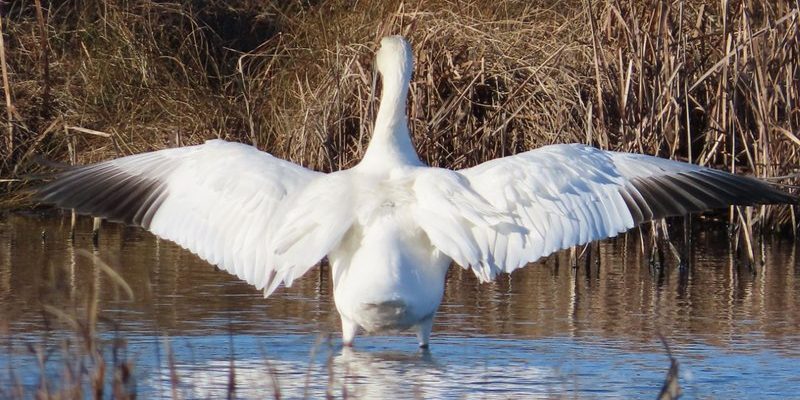
The Snow Goose is truly a spectacle to behold, gliding effortlessly across the sky with its striking white feathers and striking black wing tips. Imagine, if you will, a fluffy white cloud moving gracefully over a blue expanse—this is how the Snow Goose often appears when it takes to the air. These birds are not just beautiful; they also play a vital role in the ecosystems they inhabit during their migratory journeys.
Originating from North America, these geese are known for their incredible capacity to travel long distances. You might picture them flying thousands of miles from their breeding grounds in Canada to wintering grounds in the southern United States and Mexico. Their migratory patterns are some of the most fascinating aspects of their life cycle, showcasing their resilience as they navigate diverse landscapes and weather conditions.
Physical Characteristics
Snow Geese are medium to large-sized birds, typically weighing between 5 to 14 pounds. The males and females are similar in appearance, but the males are generally larger. Their most distinctive feature is their pure white plumage, complemented by black wingtips that add a touch of contrast. There’s also a bluish-gray variant known as the “blue goose,” which has a strikingly different appearance. The adult Snow Goose’s wing span can reach up to 60 inches, making their flight a majestic sight.
Another notable feature is their long necks and rounded heads. Their beaks, which are a vibrant pinkish-orange, are specifically adapted for grazing. This is significant because their diet primarily consists of grasses, grains, and other vegetation. Their physical adaptations allow them to thrive in various habitats, from marshes and wetlands to agricultural fields.
Habitat and Distribution
Snow Geese are migratory birds that require diverse habitats throughout their life cycle. During the breeding season, they flock to the tundra regions of Canada and Alaska, where they nest close to water bodies. These regions provide the necessary resources to raise their young. In contrast, during the winter months, they migrate to warmer areas such as the southern United States, often gathering in large flocks in fields and wetlands. Picture a vast stretch of land filled with thousands of Snow Geese; that’s the scene you might encounter during migration.
The geographical distribution of the Snow Goose spans a wide range. Breeding populations are primarily found in the Arctic and sub-Arctic regions, while wintering populations can be seen in places like Texas, California, and Louisiana. Their adaptability to changing environments makes them fascinating subjects for study among ornithologists and bird watchers alike. You could think of them as nature’s globetrotters, skillfully navigating vast spaces in search of food and shelter.
| Characteristic | Description |
| Size | Medium to large (5 to 14 lbs) |
| Wingspan | Up to 60 inches |
| Plumage | Primarily white with black wingtips |
| Diet | Grasses, grains, and vegetation |
| Breeding Habitat | Tundra regions in Canada and Alaska |
| Winter Habitat | Southern US and parts of Mexico |
| Lifespan | 10-20 years in the wild |
Behavior and Social Structure
The social structure of Snow Geese is quite fascinating. They are known to form large flocks, especially during migration and feeding. This behavior provides safety in numbers, as it minimizes the risk of predation. You might picture thousands of them swirling together in a synchronized dance as they take off from a wetland. It’s not just stunning; it also helps them navigate better. By flying in V formations, they can reduce wind resistance and save energy during long flights.
Feeding is another critical aspect of their behavior. Snow Geese are primarily grazers, and you’ll often find them in agricultural fields or marshes searching for food. They have a unique feeding technique that involves uprooting plants by their roots. This allows them to access the nutrient-rich parts of the vegetation, which is essential for maintaining their energy levels during migration.
Communication is also vital in their social interactions. Snow Geese have various vocalizations, from soft honks to loud calls that can be heard over great distances. These calls help them maintain flock cohesion and alert others to potential dangers. Imagine the soundscape filled with their calls echoing across the wetlands—it creates an immersive experience for those who observe them in their natural habitat.
Breeding and Lifecycle
Snow Geese typically breed during the summer months. Mating usually occurs in March or April, when they return to their breeding grounds. The female usually lays between 3 to 5 eggs, and both parents share incubation duties for about 24 to 30 days. Once the goslings hatch, they are precocial, meaning they can walk and swim almost immediately. This is a crucial adaptation for survival, as it allows them to escape predators more effectively.
After hatching, the family unit remains together for several weeks, as the goslings learn to forage and navigate their environment. During this time, the parents are highly protective. They will often put themselves between danger and their young, showcasing the strong parental instincts that Snow Geese possess. It’s moving to think how much effort goes into raising the next generation.
As summer ends and the days begin to shorten, the young geese are ready to migrate for the first time. This journey, often spanning thousands of miles, is a remarkable feat of endurance and navigation. It’s like a rite of passage, where the young Snow Geese learn the paths their parents took and, eventually, they will repeat this journey year after year.
Conservation Status
The Snow Goose is currently classified as a species of least concern according to the International Union for Conservation of Nature (IUCN). This classification reflects their widespread distribution and large population numbers. However, this doesn’t mean they are free from threats. Habitat loss, climate change, and hunting pressures are significant challenges that can impact their populations.
Conservation efforts are essential for maintaining healthy Snow Goose populations. Protecting their breeding and wintering habitats is crucial, as these areas provide the necessary resources for their survival. Conservation organizations are working diligently to ensure that the wetlands and agricultural fields that Snow Geese rely on are preserved and sustainably managed.
Awareness plays a critical role in conservation. By educating the public about the importance of Snow Geese and their habitats, we can foster a sense of responsibility toward nature. You might be surprised how small actions can lead to significant changes in protecting these beautiful birds and their environments.
Interesting Facts About Snow Geese
Snow Geese are more than just beautiful birds; they have some pretty cool features that make them unique. For instance, did you know that the blue morph of the Snow Goose, which has a darker plumage, can sometimes be mistaken for a different species? This variation adds to their intrigue, showing that nature loves to surprise us with diversity.
Moreover, Snow Geese can be incredibly vocal. Their honking calls can be heard during migration, and in the winter months, the chorus of their chatter creates an enchanting atmosphere in the fields where they gather. It’s one of those sounds that can transport you to the heart of nature.
Lastly, although Snow Geese are resilient creatures, some of their migratory routes have been altered by climate change. Understanding these dynamics is crucial in preserving their future and ensuring they continue to grace our skies for generations to come.
FAQ
What do Snow Geese eat?
Snow Geese primarily graze on grasses, grains, and other types of vegetation. Their feeding habits involve uprooting plants by their roots. This allows them to access nutrient-rich parts that are essential for energy, especially during migration.
How long do Snow Geese live?
In the wild, Snow Geese have a lifespan of about 10 to 20 years, though many factors, including predation and environmental conditions, can affect their longevity.
Are Snow Geese aggressive?
Snow Geese can be protective, especially when nesting or caring for their goslings. They may exhibit aggressive behavior toward perceived threats. It’s a testament to their strong parental instincts, which help keep their young safe.
Why are Snow Geese important to their ecosystems?
Snow Geese play a crucial role in their ecosystems by helping to manage plant growth through grazing. Their feeding habits can influence the vegetation in their habitats, which in turn affects other species that share the same environment.
What is the difference between a Snow Goose and a Blue Goose?
The primary difference is in their coloration. While Snow Geese are mostly white with black wingtips, Blue Geese have a bluish-gray plumage. Both are the same species but exhibit different color morphs that can be confusing at first glance.
How do Snow Geese migrate?
Snow Geese migrate in large flocks, often flying in V formations that provide aerodynamic benefits. They travel thousands of miles between breeding and wintering grounds, typically guided by changes in daylight and weather conditions.
Where do Snow Geese breed?
Snow Geese typically breed in the tundra regions of Canada and Alaska. This habitat provides the necessary resources for raising their young. They nest near water bodies, which offer protection and food sources.
How can I help protect Snow Geese?
You can help protect Snow Geese by supporting conservation organizations and participating in habitat restoration projects. Additionally, being mindful of our environmental impact and advocating for sustainable practices can contribute to the preservation of their habitats.
Can Snow Geese be found outside North America?
While Snow Geese are primarily found in North America, some may migrate to parts of northern Mexico for the winter. Their migratory routes are generally concentrated within North America.
What are some threats to Snow Geese?
Threats to Snow Geese include habitat loss due to urban development, climate change affecting their migratory patterns, and hunting pressures. Understanding these threats is crucial for effective conservation efforts.
How often do Snow Geese molt?
Snow Geese undergo a molting process once a year, typically after the breeding season. During this time, they shed old feathers and grow new ones, which is essential for maintaining their flight capabilities.
What is the significance of Snow Geese in local cultures?
In many Indigenous cultures, Snow Geese hold significant cultural importance. They are often associated with seasonal changes and are celebrated in various traditional practices. Their migration has been historically observed and integrated into cultural stories and celebrations.
What sounds do Snow Geese make?
Snow Geese produce a variety of vocalizations, including honking calls that can be heard during migration and while in their wintering grounds. Their chatter creates a vibrant soundscape that adds to the experience of observing them in the wild.

